TL;DR: The difference between pathogenic and non-pathogenic is circumstantial. Pathogen-specific proteins are proportionally rare, as bacteria growing in tissues are heterogeneous and the microenvironment controls the bacterial gene profile. The bacterial cells try to change the microenvironment so that the fittest non-pathogenic population grows.
Hygiene is important, but no matter how clean you are there's a high chance you'll never get rid of all your germs. After all, their calculated number exceeds the number of cells in your body (estimates go to 1.3 times, with frequent and high variation due to defecation).1
They are not only bad, some of them can be beneficial. We can coexist without a disease appearing. why the difference? What makes an organism good or bad for us?
Colonization
If bacteria live in a particular tissue permanently without causing an immune response are said to be colonizing that place, the difference between colonization and infections is circumstantial. They can cause disease or not. An example of a bacteria that colonize and has a high risk of causing disease is Staphylococcus aureus.
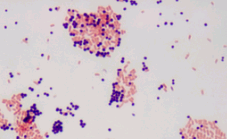
[Image source: link]
The prevalence of colonization for S. aureus in the nares is 30% (20 parmanent-80% occasional) in the whole human population2. When it becomes pathogenic has mortality rates 20-40% despite appropriate treatment at 30 days after infection3 due to deep tissue infections like Cellulitis, osteomyelitis, septic arthritis, endocarditis, bacteremia, pneumonia, and meningitis. Even after decolonization treatment, persistent carriers get re-colonized reverting to their previous state. While non-carriers seem to have biological protection against adhesion and invasion, if they become infected, the outcomes are similar. Even after this difference has been identified, viable points of intervention for vaccines or passive immunity are not promising4
For an organism to colonize it must come into contact with us. For instance, in the case of gastrointestinal flora it's believed we acquire most of it for our mothers,5 once there, it multiplies and spreads.
In the case of pathogenic organisms, they go through the same steps but additionally, they cause harm. Some of the main features of harm are tissue structure alteration, loss of organ function and growth in otherwise sterile sites. This is not bugs, they are features in pathogenic organisms.
They achieve this by antagonizing host-defenses. A particular example of this is meningitis. Organisms that cause meningitis have a capsule, which makes phagocytosis by white blood cells difficult and spread to sterile sites easier. Another one, that is quite dramatic is the production of exotoxins.
Toxins
The first type of toxins is called membrane active exotoxins.
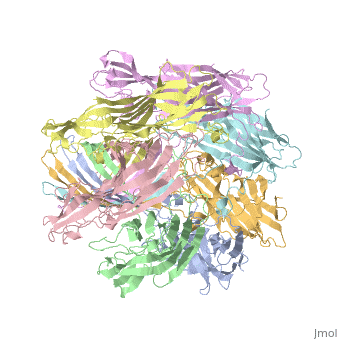
Most of them create a pore-like structure. In the case of Hemolysin, the multimeric structure makes a pore. When secreted is in soluble form and when it reaches the membrane it undergoes a conformational change in which the ϐ-sheet structure inserts into the membrane.6
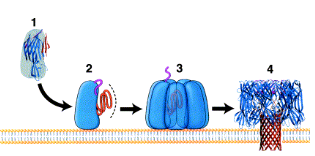 one of the main purposes of this is nutrients sequestration. Particularly important is iron. Many bacteria have multiple pathways and toxins to achieve this sequestration. 7 membrane active toxins are also used to misregulate recognition by phagocytes or to escape the phagocytic membrane once they are inside phagocyte in order to parasitize them.
one of the main purposes of this is nutrients sequestration. Particularly important is iron. Many bacteria have multiple pathways and toxins to achieve this sequestration. 7 membrane active toxins are also used to misregulate recognition by phagocytes or to escape the phagocytic membrane once they are inside phagocyte in order to parasitize them.
A second type is translocated proteins. They target regulatory proteins within the host cells, particularly common is the case of GTP-binding proteins cascades, that include cell membrane traffic, cytoskeleton dynamics and translation.for instance they target the RHO family of GTPases, by bacterial transferases by modifications through ADP-ribosylation, glucosylation, adenylylation, proteolysis, deamidation and transglutamination that lock the proteins into either the ON (GTP bound) or OFF (GDP bound) position.8 They also mimic the host activation proteins such as guanine nucleotide exchange factors (GEFs) which force conversion of the GDP bound form of the protein to the GTP bound form using their own bacterial form (BGEFs). The opposite effect is done by GTPase activating proteins that force the binding to GDP.
As these proteins are soluble, in order to perform this activity they require bypassing cell membranes. They do it by the AB type toxin mechanism. They have assembled in two subunits: the A subunit which is active in the cytoplasm and the B subunit that binds to the membrane and then allows the active subunit to translocate in the cell's cytoplasm, like the cholera toxin.9
Some organisms have specialized secretion systems. Translocated bacterial proteins often target phagocytes, as phagocytes are an extremely effective defense mechanism. The main strategies of phagocytes:
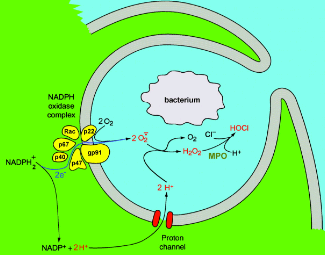
- Oxidative killing mechanisms such as the NADPH complex, which assembles on the host cell complex in response of a binding of a microorganism to the surface of a phagocyte, mainly in the case of neutrophils.10 Here the complex transforms molecular oxygen to free radicals and other products that are highly antibacterial, like hydrogen peroxide.
Small cationic antimicrobial peptides are found in membrane-bound compartments and they are released either into the extracellular space or in a compartment known as the phagosome that engulfs the microorganism. By forming transmembrane pores or by binding of intracellular molecules, also they have immunomodulatory effects by modulating the response of dendritic cells and hold high therapeutic potential 11
Nuetrophils in response to a pathogen perform something called a NET (neutrophil extracellular traps), is a process that results in the death of the neutrophil and then eliciting of DNA and histones in the extracellular regions, that are antimicrobial 12
- A late response is Nitric oxide, by INOS host cells. That combine L-arginine and molecullar oxygen to form citrulline and NO, that converts to intermediates.
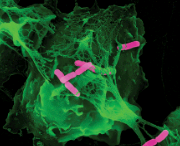
:Nature cover]
What does it mean to colonize a tissue?
There are two types of colonization patterns that can occur. One where the whole population remains homogeneous and in a single place, similar to what happens in broth culture vs the apparition of individual colonies like in an agar plate.
The broth model is more likely to occur in blood and non-pathogenic colonizers.
Innoculation into a deep organ occurs after bacteria, penetrate an epithelial surface. For instance by going from the intestine to the spleen the number of bacteria that enter the bloodstream and arrive at a tissue is relatively low. The invasion is not even and bacteria act as founders, giving rise to individual heterogeneous colonies instead of forming a uniform group. 13
The encounter of immune host cells with bacteria is not uniform, by aggregation cells in the center of colonies are not directly exposed. Some bacteria like Yersinia have type III secretion systems that allow translocation of a protein into the host cell which interferes with phagocytosis. The way these proteins are able to move from the bacteria into the host-cell is through a needle-like structure on the surface of the bacteria.14 Once inside proteins like YopE targets small GTPases and inactivate RHO family members to prevent phagocytosis.
It has been shown that in bacterial species like shigella, have different responses to microenvironments. Bacteria that were growing near the interface with the host epithelium had different gene expression and virulence in response to oxygen tension when compared to bacteria growing in the lumen.15
As I mentioned earlier in my immunofluorescence microscopy post, GFP which glows green requires oxygen for fluorescence maturation and is used as an oxygen sensor.
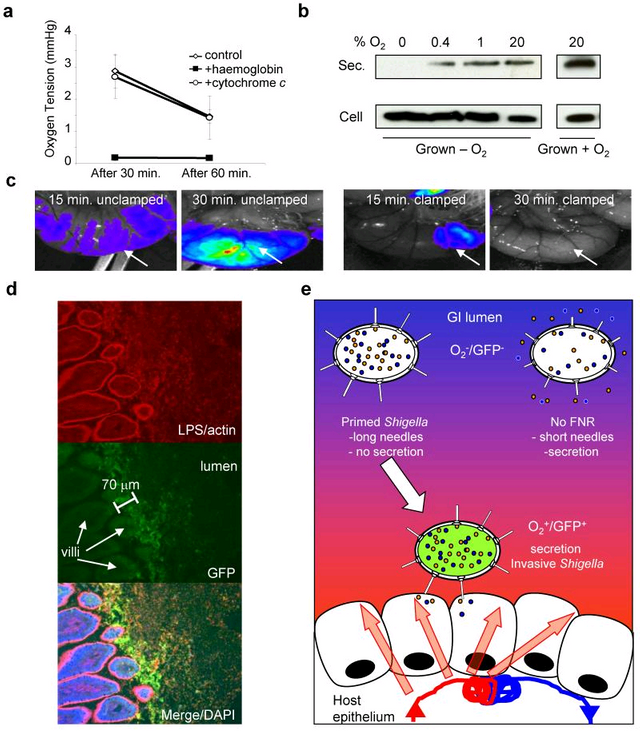
pathogenic properties: Nature. 2010 May 20; 465(7296): 355–358.]
In the case of bacteria that grow the lumen, they have almost no green fluorescence as the oxygen tension is higher near the lumen.
In the case of YopE, the gene is upregulated when bacteria are in contact with host cells when compare to when they are not 16 which suggests there's spatial variation in the expression of pathogenic proteins during tissue infection. This community behavior has the purpose of changing the microenvironment so the bacteria in the center can avoid immunity and grow. Having different each small isolated micro population different adaptations like adaptations to nitrogen oxide intermediaries as shown by hmp expression17
This creates a fitness compromise for bacteria, where the population in the periphery can't reproduce as fast, which leads to the development of bacteria that don't have the adaptation.
References

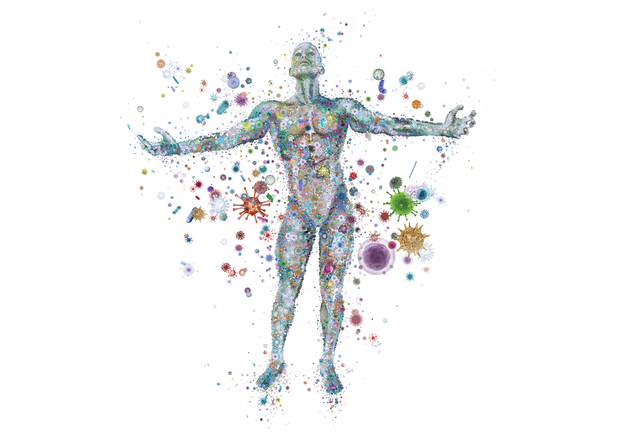
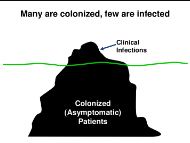
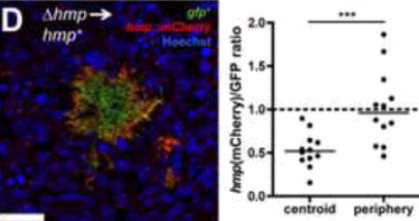
Really informative, thanks!
Downvoting a post can decrease pending rewards and make it less visible. Common reasons:
Submit
Informative post . Thank u
Downvoting a post can decrease pending rewards and make it less visible. Common reasons:
Submit
Congratulations @ertwro! You have completed some achievement on Steemit and have been rewarded with new badge(s) :
Click on any badge to view your own Board of Honor on SteemitBoard.
For more information about SteemitBoard, click here
If you no longer want to receive notifications, reply to this comment with the word
STOPDownvoting a post can decrease pending rewards and make it less visible. Common reasons:
Submit
Great post! Looking forward to seeing more! Resteemed:).
Downvoting a post can decrease pending rewards and make it less visible. Common reasons:
Submit